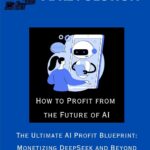In an era where artificial intelligence and automation are transforming industries overnight, The Future of Work: AI, Robots, and Automation emerges as an essential guide for anyone looking to understand and adapt to these seismic changes. This thought-provoking book doesn’t just speculate about tomorrow’s workplace – it provides a clear-eyed analysis of how technology is reshaping careers, businesses, and economies, along with practical strategies to thrive in the new landscape.
Overview of the Book
The book is organized into three insightful sections that progressively build our understanding of the work revolution:
-
The Changing Landscape – Examines how AI and robotics are already disrupting traditional jobs across sectors
-
The Skills Revolution – Identifies the human abilities that will remain valuable in an automated world
-
Adaptation Strategies – Provides actionable advice for individuals and businesses to future-proof themselves
What sets this book apart is its balanced perspective. Rather than painting a dystopian future of mass unemployment or an unrealistic utopia, it presents nuanced scenarios based on current trends and credible research.
Key Strengths
1. Comprehensive Yet Accessible Analysis
The author masterfully breaks down complex technological concepts into digestible explanations without oversimplifying. Even readers with no technical background will appreciate the clear descriptions of machine learning, robotic process automation, and other key technologies.
2. Data-Driven Projections
Unlike many speculative works about the future, this book grounds its predictions in current data and trends. The author cites numerous studies from McKinsey, Oxford University, and the World Economic Forum to support projections about job market changes.
3. Practical Career Advice
The most valuable section offers concrete strategies for workers at all levels:
-
How to identify automation-resistant skills
-
Ways to combine technical knowledge with human strengths
-
Roadmaps for transitioning between careers
-
Tips for lifelong learning in the digital age
4. Balanced Perspective on Automation
The book thoughtfully examines both sides of the automation debate – discussing potential job losses while also highlighting new categories of employment that may emerge. This balanced approach makes the arguments more credible and useful.
Potential Limitations
1. Rapidly Evolving Subject Matter
As with any book about technology, some specifics may become dated quickly. However, the core principles about adaptability and skill development remain timeless.
2. Could Expand on Policy Solutions
While excellent for individual workers, the book gives relatively brief treatment to societal and policy responses that could ease workforce transitions.
3. Varied Impact Across Industries
Some readers might want more industry-specific analysis, as automation affects manufacturing, healthcare, and creative fields quite differently.
Who Will Benefit Most From This Book?
-
Working professionals concerned about job security
-
Students and career changers making education decisions
-
Entrepreneurs and business leaders planning for workforce changes
-
Policy makers and educators preparing for economic shifts
-
Anyone curious about how technology will shape our working lives
Standout Features
-
“Future-Proof Skills” Framework – A brilliant taxonomy of abilities that complement rather than compete with AI
-
Industry Impact Scorecards – Clear ratings showing which sectors face most/least disruption
-
Worker Case Studies – Real examples of people who successfully adapted to automation
-
Action Checklists – End-of-chapter summaries with concrete next steps
Final Assessment
The Future of Work: AI, Robots, and Automation delivers exactly what its title promises – a comprehensive, readable, and practical examination of how technology is transforming employment. While it doesn’t shy away from the challenges automation presents, its ultimately empowering message is that adaptability and continuous learning can help workers not just survive but thrive in the new economy.
The book’s greatest achievement is striking the perfect balance between warning about coming disruptions and providing hope through actionable solutions. It serves as both a wake-up call and a survival guide for the Fourth Industrial Revolution.
Rating: 4.9/5
Recommendation: Essential reading for anyone who plans to work in the next 20 years
This book doesn’t just predict the future – it helps you prepare for it. Whether you’re an employee, employer, or policymaker, the insights here will prove invaluable in navigating the workforce transformations ahead. Five years from now, we may look back at this as one of the most important business books of our time.




